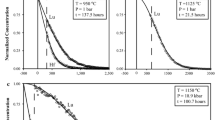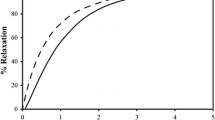Abstract
The kinetics of He migration from zircon of variable degree of metamictization was investigated. The migration parameters of He were experimentally determined, the influence of radiation damage and the degree of metamictization on the stability of the (U-Th)/He isotope system was evaluated, the mechanisms of noble gas escape from zircon were investigated, new data on the kinetics of He migration were obtained and compared with previous results for the kinetics of Xe migration from zircon of the same geologic objects. It was shown that He occurs in two energy positions in the zircon lattice: the main position (more than 80% He) with an activation energy of ∼39 kcal/mol and k 0 = 1011 yr−1 and the second position with an activation energy for migration of 5–10 kcal/mol and k 0 ∼ 106 yr−1. It was concluded that He migration from the main energy position is better described by a single-jump mechanism. The migration of He from the second energy position is consistent with the diffusion mechanism. It was shown that deviations from the linear dependence in the lnln(He0/Het)-1/T coordinates are probably related to the destruction of volume defects containing He atoms at high temperatures (more than 1000°C on the experimental time scale) resulting in a change from the single-jump to diffusion mechanism and the presence of atoms migrating via the diffusion mechanism. It was shown that the peak width in the spectrum of radiogenic He release and the appearance of a second peak also depend on the fraction of atoms migrating in accordance with the diffusion mechanism. It was found that the low activation energy for He release from the second energy position indicates the existence of continuous He loss from the zircon lattice.
Similar content being viewed by others
References
Aciego, S., Kennedy, B., DePaolo, D., Christensen, J., and Hutcheon, I., U-Th/He Age of Phenocrystic Garnet from the 79 AD eruption of Mt. Vesuvius, Earth Planet. Sci. Lett., 2003, vol. 219, pp. 209–219.
Aciego, S., DePaolo, D., and Kennedy, B., Combining [3He] Cosmogenic Dating with U-Th/He Eruption Ages using Olivine in Basalt, Earth. Planet. Sci. Lett., 2007, vol. 254, pp. 288–302.
Blackburn, J, Stockli, D., and Carlson, R., (U-Th)/He Dating of Kimberlites-A Case Study from North-Eastern Kansas, Earth Planet. Sci. Lett., 2008, vol. 275, pp. 111–120.
Cherniak, D.J., Watson, E.B., and Thomas, J.B., Diffusion of Helium in Zircon and Apatite, Chem. Geol., 2009, vol. 268, pp. 155–166.
Dickin, A., Radiogenic Isotope Geology, 2004, http://www.onafarawayday.com/Radiogenic.
Dodson, M.H., Closure Temperature in Cooling Geochronological and Petrological Systems, Contrib. Mineral. Petrol., 1973, vol. 40, pp. 259–274.
Dunai, T.J., Forward Modeling and Interpretation of (U-Th)/He Ages, Rev. Mineral. Geochem., 2005, vol. 58, pp. 259–274.
Farley, K., He Diffusion Systematic in Minerals: Evidence from Synthetic Monazite and Zircon Structure Phosphates, Geochim. Cosmochim. Acta, 2007, vol. 71, pp. 4015–4024.
Farley, K.A. and Stockli, D.F., (U-Th)/He Dating of Phosphates: Apatite, Monazite, and Xenotime, Rev. Mineral. Geochem., 2002, pp. 559–577.
Gerling, E.K., Sovremennoe sostoyanie argonovogo metoda opredeleniya absolyutnogo vozrasta i ego primenenie v geologii (Modern State of Argon Method of Age Determination and its Application in Geology), Moscow: Akad. Nauk SSSR, 1961.
Gerling, E.K., Heat of Helium Diffusion as Criterion for Suitability of a Mineral for Age Determination using He Method, Dokl. Akad. Nauk SSSR, 1939, vol. 24, no. 6, pp. 570–573.
Ghoniem, N., Sharafat, S., and Williams, J. Theory of Helium Transport and Clustering in Materials under Irradiation, J. Nucl. Mater., 1983, vol. 117, pp. 96–105.
Gol’tsev, V.P. and Guseva, T.M., Properties and Behavior of Boron Carbide under Irradiation, in Pogloshchayushchie materialy i sterzhni regulirovaniya bystrykh reaktorov, (Absorbing Materials and Regulation Rods of Rapid Reactors), 1973, pp. 293–316.
Holland, H.D., Radiation Damage and Its Use in Age Determination, in Nuclear Geology, Faul, H., Ed., New York: Wiley, 1954, pp. 175–179.
Hurley, P.M., The Helium Age Method and the Distribution and Migration of Helium in Rocks, in Nuclear Geology, Faul, H., Ed., New York: Wiley, 1954, pp. 301–329.
Kamaev, D.N., Arguchov, S.A., and Mikhailov, G.G., Study and Thermodynamic Description of the ZrO2-SiO2 System, Fiz. Khim. Tekhnol. Neorg. Mater., 2004, vol. 4, no. 26, pp. 39–41.
Krylov, D.P. and Shukolyukov, Yu.A., Xenon Migration in Zircon, Petrologiya, 1994, vol. 2, no. 3, pp. 259–265.
Krylov, D.P. and Shukolyukov, Yu.A., Xes-Xen Age of Two Zircon Samples from the Napier Complex, Enderby Land, East Antarctica, Petrologiya, 2003, vol. 11, no. 1, pp. 102–109 [Petrology (Engl. Transl.), vol. 11, no. 1, pp. 94–98].
Low Temperature Thermochronometry, Rosso, J.J., Ed., Rev. Mineral. Geochem., 2005, vol. 58.
Mortimer, E., Foeken, J., Strecker, M., and Stuart, F., Evolution of a Young Rift Border-Fault System Constrained by Low Temperature (U-Th/He) Thermochronometry: North Basin, Malawi Rift, East Africa, 2006, www.agu.org.
Neklyudov, I.M. and Tolstolutskaya, G.D., Gelii i vodorod v konstruktsionnykh materialakh (Helium and Hydrogen in Constructional Materials), Khar’kov: Khar’k. Fizikotekh. Inst., 2003, pp. 1–15.
Ozima, M. and Podosek, M.A., Noble Gas Geochemistry, Cambridge: University Press, 1983.
Pettke, T., Frei, R., Kramers, J.D., and Villa, I.M., Isotope Systematics in Vein Gold from Brusson, Val d’Ayas (NW Italy) 3. (U + Th)/He and K/Ar in Native Au and Its Fluid Inclusions, Chem. Geol., 1997, vol. 135, pp. 173–185.
Reich, M., Ewing, R., Ehlers, T., and Becker, U., Low-Temperature Anisotropic Diffusion of Helium in Zircon: Implications for Zircon (U-Th)/He Thermochronometry, Geochim. Cosmochim. Acta, 2007, vol. 71, pp. 3119–3130.
Reiners, P., Zircon (U-Th)/He Thermochronometry, Rev. Mineral. Geochem, 2005, vol. 58, pp. 151–179.
Rutherford, E., Radioactive Transformations, New York: Charles Scriber’s Sons, 1906.
Saadoune, I., Purton, J., and Leeuw, N., He Incorporation and Diffusion Pathways in Pure and Defective Zircon ZrSiO4: A Density Functional Theory Study, Chem. Geol., 2009, vol. 258, pp. 182–196.
Shukolyukov, Yu.A. and Ashkinadze, G.Sh., Complex Study of Helium, Argon, Xenon, and Krypton Migration in Some Minerals, Geokhimiya, 1967, no. 10, pp. 1082–1987.
Shukolyukov, Yu.A., Fugzan, M.M., Paderin, I.P., Sergeev, S.A., and Krylov, D.P., Geothermochronology Based on Noble Gases: I. Stability of the U-Xe Isotope System in Nonmetamict Zircon, Petrologiya, 2009, vol. 17, no. 1, pp. 3–27 [Petrology (Engl. Transl.), vol. 17, no. 1, pp. 1–24].
Shuster, D. and Farley, K., The Influence of Artificial Radiation Damage and Thermal Annealing on Helium Diffusion Kinetics in Apatite, Geochim. Cosmochim. Acta, 2009, vol. 73, pp. 183–196.
Shuster, D., Flowers, R., and Farley, K., The Influence of Natural Radiation Damage on Helium Diffusion Kinetics in Apatite, Earth Planet. Sci. Lett., vol. 249, 2006, pp. 148–161.
Starik, I.E., Yadernaya geokhronologiya (Nuclear Geochronology), Moscow-Leningrad: Akad. Nauk SSSR, 1961.
Strutt, R., The Accumulation of Helium in Geologic Time, III. Proc. Roy. Soc. London. Ser. A, 1910, vol. 83, pp. 298–301.
Svetukhin, V.V., Suslov, D.N., and Risovanyi, V.D., Model’ desorbtsii inertnykh gazov iz obluchennykh reaktornykh materialov, (Model of Desorption of Inert Gases from Iradiated Reactor Materials), 2005, http://www.niir.ru.
Wolf, R.A., Farley, K.A., and Kass, D.M., Modelling of the Temperature Sensitivity of the Apatite (U-Th)/He Thermochronometer, Chem. Geol., 1998, vol. 148, pp. 105–114.
Zeitler, P.K., Herczeg, A.L., McDougall, I., and Honda, M., (U-Th)/He Dating of Apatite: a Potential Thermochronometer, Geochim. Cosmochim. Acta, 1987, vol. 51, pp. 2865–2868.
Zircon, Rev. Mineral. Geochem. Hanchar, J.M., and Hoskin, P.W., Ed., 2003, vol. 53.
Author information
Authors and Affiliations
Corresponding author
Additional information
Original Russian Text © O.V. Yakubovich, Yu.A. Shukolyukov, A.B. Kotov, S.Z. Yakovleva, E.B. Sal’nikova, 2010, published in Petrologiya, 2010, Vol. 18, No. 6, pp. 579–594.
This contribution is part of a series that began from the paper of Yu. A. Shukolyukov, M. M. Fugzan, I. P. Paderin, S. A. Sergeev, and D. P. Krylov, “Geothermochronology Based on Noble Gases: I. Stability of the U-Xe Isotope System in Nonmetamict Zircon,” Petrologiya, 17 (1), 3–27 (2009). [Petrology, 17, 1–24 (2009)].
Rights and permissions
About this article
Cite this article
Yakubovich, O.V., Shukolyukov, Y.A., Kotov, A.B. et al. Geothermochronology based on noble gases: II. Stability of the (U-Th)/He isotope system in zircon. Petrology 18, 555–570 (2010). https://doi.org/10.1134/S0869591110060019
Received:
Published:
Issue Date:
DOI: https://doi.org/10.1134/S0869591110060019




